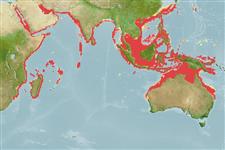Common names from other countries
>
Callionymiformes (Dragonets) >
Callionymidae (Dragonets)
Etymology: Callionymus: Greek, kallion, comparative of kallos = beautiful + Greek, onyma = name; with a better name .
More on author: Valenciennes.
Environment: milieu / climate zone / depth range / distribution range
Ecologie
marien demersaal; diepte 2 - 350 m (Ref. 58488), usually 5 - 100 m (Ref. 89972). Subtropical; 30°N - 27°S, 32°E - 169°E
Indo-West Pacific: Red Sea south to Delagoa Bay, Mozambique and eastward to Taiwan. Migrated to the Mediterranean Sea via the Suez Canal (Ref. 5385).
Grootte / Gewicht / Leeftijd
Maturity: Lm ? range ? - ? cm
Max length : 20.0 cm TL mannelijk / geslacht onbekend; (Ref. 4405)
Dorsale stekels (totaal) : 4; Dorsale zachte stralen (totaal) : 9; Anale stekels: 0; Anale zachte stralen: 9. Light brown in color with dark spots on sides; fins with dark brown spots; males with black stripes or blotches on 1st dorsal fin, females with black blotch on 3rd membrane (Ref. 4405). Ventral margin of preopercular spine convex (Ref 42832).
Found on sandy and muddy substrate of the coastal area down to a depth of about 100 m (Ref. 5213). Minimum depth reported taken from Ref. 4405. Feeds on small benthic invertebrates, mainly crustaceans and worms (Ref. 5968). Minimum depth of 2 m reported from Ref. 90102.
Levenscyclus en paargedrag
Maturities | Voortplanting | Spawnings | Egg(s) | Fecundities | Larven
Bauchot, M.-L., 1987. Poissons osseux. p. 891-1421. In W. Fischer, M.L. Bauchot and M. Schneider (eds.) Fiches FAO d'identification pour les besoins de la pêche. (rev. 1). Méditerranée et mer Noire. Zone de pêche 37. Vol. II. Commission des Communautés Européennes and FAO, Rome. (Ref. 3397)
Status op de Rode Lijst van het IUCN (Ref. 130435)
CITES (Ref. 128078)
Not Evaluated
Gevaar voor de mens
Harmless
Gebruik door de mens
Visserij: van geen belang
Tools
Speciale rapporten
Download XML
Internetbronnen
Estimates based on models
Preferred temperature (Ref.
115969): 17.9 - 27.9, mean 24 (based on 810 cells).
Fylogenetische diversiteitsindex (Ref.
82804): PD
50 = 0.5000 [Uniqueness, from 0.5 = low to 2.0 = high].
Bayesian length-weight: a=0.01148 (0.00668 - 0.01973), b=2.76 (2.62 - 2.90), in cm Total Length, based on LWR estimates for this species & Genus-body shape (Ref.
93245).
Trofisch niveau (Ref.
69278): 3.3 ±0.39 se; based on food items.
Weerstandsvermogen (Ref.
120179): Gemiddeld, minimale populatieverdubbelingstijd 1,4-4,4 jaar (Preliminary K or Fecundity.).
Fishing Vulnerability (Ref.
59153): Low vulnerability (10 of 100).
